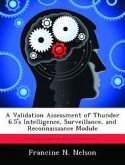Joint Force commanders, military services and governmental agencies recently stated an operational requirement for a persistent intelligence, surveillance, and reconnaissance (ISR) capability. The need for persistence implies a need to detect, identify, and characterize change in a target's status anywhere, anytime, in any weather, with increasingly higher levels of fidelity. Persistent ISR is the ability to do this with sufficient timeliness and precision to achieve the Joint Force Commander's (JFC) objectives. The Global War on Terror's (GWOT) multitude of threats demands an ISR capability with the persistence to find, fix, and track single individuals in a crowd; locate camouflaged, concealed, or mobile weapons of mass destruction (WMDs); and monitor any area on the globe sufficiently enough that meaningful changes can be detected and correctly interpreted in near-real-time. The persistent ISR capability would provide combatant commanders with assured and continued observational access to the multitude of elusive adversaries operating in their area of responsibility. However, is the realization of persistence currently achievable in the Department of Defense (DoD)? Insufficient intelligence collection platforms coupled with convoluted command and control responsibilities currently limit the Department's capability to achieve persistence in the near term.
Bitte wählen Sie Ihr Anliegen aus.
Rechnungen
Retourenschein anfordern
Bestellstatus
Storno









